AMAZON multi-meters discounts AMAZON oscilloscope discounts
OBJECTIVES
• Explain the effect of electric current on the human body.
• Understand the injuries that are possible from an electrical shock.
• Know the basic procedures in the event of an electrical shock.
• Understand the importance of properly grounding tools and appliances.
• Safely use electrical hand tools and electrical meters.
• Follow the principles of safety when installing and servicing heating and air-conditioning equipment.
KEY TERMS
- Cardiopulmonary resuscitation (CPR)
- Circuit breaker
- Circuit lockout
- Conductor
- Double insulated
- Electrical shock
- Electromotive force
- Fuse
- Ground
- Ground fault circuit interrupter (GFCI)
- Grounding adapter
- Live electrical circuit
- National Electrical Code® (NEC®)
- Three-prong plug
INTRODUCTION
Electricity is very commonplace in our environment today; in fact it’s hard for us to envision life without electricity. No matter what part of our lives we examine, electricity plays an important role, from our home life to our places of employment. Our homes are filled with personal electric appliances like toothbrushes and hair dryers, small electric appliances like mixers and toasters, major appliances like washers and refrigerator/freezers, and large equipment that heats and cools our living spaces. Many people work in environments that use large electrical equipment that's powered by an extremely high-voltage source. No matter what a person does, he or she is likely to come near to electrical power sources that are dangerous.
The single most important element to remember when dealing with electrical circuits is to respect them. It is impossible for a service technician to adequately troubleshoot heating and air conditioning with the electrical power turned off, so it's imperative to use safe procedures when the power is on. Many troubleshooting procedures can be performed with the electric power to the equipment interrupted, such as checking the condition of electric motors, relays, contactors, transformers, and other electrical devices. However, there are other times when troubleshooting requires a connection to the power source—checking power available to the equipment, checking power avail able to a specific electrical device, or checking the voltage drop across a set of contacts in a relay, for example. The important thing for a HVACIR technician to know is when it's necessary to have the power to the unit on or off.
Caution: Always perform repairs with the power off.
One of the most important things that a service technician must learn is how to safely work around equipment when the power is being supplied to the equipment. Good service technicians cannot fear being shocked, but they must always pay attention to what they are doing and not get careless when they are working around live electrical circuits. A live electrical circuit's one that's being supplied with electrical energy. It is possible for an installation technician to completely install a heating and air-conditioning system without the power being turned on until it's time to check the system for proper operation. No matter what part of the heating, ventilating, and air-conditioning industry a person works in, it's imperative that he or she respects electricity and knows how to properly work around it without being injured.
1 ELECTRICAL INJURIES
Electrical shocks and burns are common hazards to personnel who are employed in the heating and air-conditioning industry. It is impossible to install or troubleshoot air-conditioning equipment without working close to electrical devices that are being supplied with electrical energy. It is the responsibility of the technician to develop a procedure for working around live electric circuits without coming in contact with conductors and electrical components that are being supplied with electrical power.
Electrical shock occurs when a person becomes part of an electrical circuit. When electricity passes through the human body, the results can range from death to a slight, uncomfortable stinging sensation, depending upon the amount of electricity that passes through the body, the path that the electricity takes, and the amount of time that the electricity flows. Technicians should never allow themselves to become the conductor between two wires or a hot and a ground in an electrical circuit.
The amount of electrical energy needed to cause serious injury is very small. The electrical energy supplied to an electrical circuit's called electro motive force, and it's measured in volts. In the heating and air-conditioning industry, the technician often is in close proximity to 24 volts, which is used for the control circuits of most residential systems; 120 volts, which is used to operate most fan motors in gas furnaces; 240 volts, which is used to operate compressors in residential condensing units; and much higher voltages, which are used to operate compressors in commercial and industrial cooling systems. The heating and air-conditioning technician is often around volt ages that can cause serious injury or even death.
Your body can become part of an electrical circuit in many ways. First, your body can become part of an electrical circuit if you come in contact with both a conductor that's being supplied with power and the neutral conductor or ground at the same time, as shown in ill 1. The ground in an electrical system is a conductor that's utilized primarily to protect against faults in the electrical system and does not normally carry current. The neutral is a current carrying conductor in normal operation and is connected to the ground. Another way that you can become part of an electrical circuit's to come in contact with both a conductor that's being supplied with power and with the ground, as shown in ill 2. A conductor is a wire or other device that's used as a path for electrical energy to flow. You may become part of the electrical circuit if you touch two conductors that are being supplied with electrical energy, as shown in ill 3.
The severity of injury from electric shock is directly related to the path that current flow takes in the body. The current flow is the amount of electrons flowing in a circuit and is measured in amperes. E.g., if the thumb and index finger of the same hand come in contact with a conductor that's supplied with electrical energy and a neutral as shown in ill 4, then the path would only be from the thumb to the index finger. If you touch a conductor being supplied with electrical energy with one hand and another conductor being supplied with electrical energy with the other hand, then the electrical path would be from one hand up the arm and across the heart to the other arm and to the hand, as shown in ill 5. If the path is through an arm and a leg, then it would also cross or come near to the heart. When the path of electrical flow crosses the heart, the risk of serious injury increases. Most fatal electrical accidents happen when the electrical flow is passed near or through the heart. When the electrical path crosses near or through the heart for only a short period of time, it can cause ventricular fibrillation of the heart, in which the heart only flutters instead of beats and the blood flow to the body stops. Unless the heartbeat is returned to normal quickly, the person will usually die without immediate medical attention.
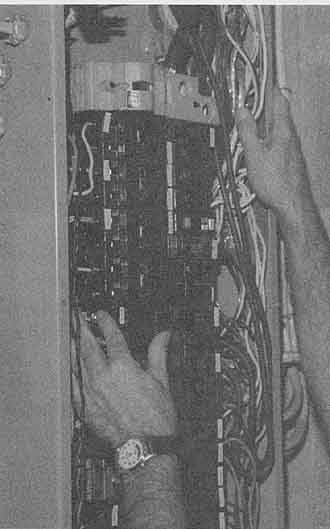
ill. 1 Technician becoming part of an electrical circuit by coming in
contact with L1 and neutral
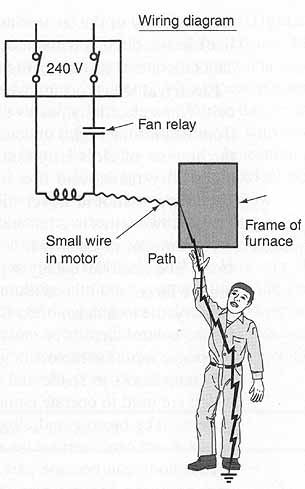
ill. 2 Technician coming in contact with a conductor (shorted fan motor) and ground. Small wire in motor; Frame of furnace; Fan relay.

ill. 3 Technician touching L1 and L2 in an electrical panel.
ill. 4 Electrical path from technician’s thumb to index finger.
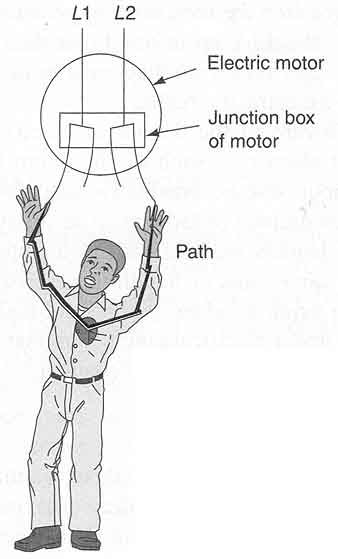
ill. 5 Electrical path across a technician’s heart.
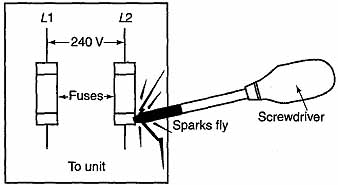
ill. 6 Screwdriver shorted between L2 and ground.
The other injury caused by electrical shock is burns to the body. This usually occurs when the technician is shocked with high voltage. Electrical burns can come from an electrical arc, such as the arc from a high-voltage transformer, the arcing of high voltage, and a short circuit to ground, where electrons are allowed to flow unrestricted. E.g., if you are working in an electrical panel with a screwdriver and allow the blade of the screwdriver to touch a ground while in contact with a conductor that's being supplied with electrical energy, the potential difference is tremendous, and sparking will usually occur, as shown in ill 6. If the resistance is very small, then the current flow in the circuit will be very large. A current flow through the body of 0.0 15 ampere or less can prove fatal. By comparison, the current draw of a 60-watt light bulb is only 0.50 ampere.
Another danger of electrical shock is a person’s reaction when shocked. E.g., if you are working on a ladder and get shocked, you could fall off the ladder. If you are using an electrical-powered hand tool and a short occurs, then you might drop the tool, causing personal injury to your self or others. Technicians should keep in mind that their reactions when getting shocked could endanger others, so they must be cautious and attentive when working near live electrical circuits.
Technicians should be aware of the danger of electrical shock when using ladders that conduct electricity, such as aluminum ladders. If at all possible, the technician should use nonconductive ladders on all jobs. The two primary types of nonconductive ladders used today are wood and fiberglass. Nonconductive ladders work as well as the aluminum ladders, except that they lack the same ease of handling because of their added weight. Whenever you are using a ladder, you should make sure that you don't position the ladder under electrical conductors that you might accidentally come in contact with when climbing the ladder.
2 DEALING WITH SHOCK VICTIMS
The first concern when assisting an electrical shock victim who is still in contact with an electrical source is personal safety. If an electrical accident occurs, personnel trying to assist a shock victim shouldn't touch a person who is in contact with an electrical source. The rescuing party should think fast, proceed with caution, and request medical assistance.
Often when someone receives an electrical shock, they cannot let go of the conductor that's the source of the electrical energy. The person who is trying to help should never come in direct contact with the victim. If you try to remove a shock victim from an electrical source that's holding the victim, you become part of the circuit, and there will be two victims instead of one. Rescuers should think before they act. If the switch to disconnect the power source is close by, then turn the switch off. If the switch to disconnect the electrical power source isn't close by or cannot be located, then use some nonconductive material to push the victim away from the electrical source. The material used to remove the victim from the electrical source should be dry to reduce the hazard of shock to the person attempting the rescue. If there are wires lying close to the victim and the rescuer is unsure if they are still connected to a power source, then the wires should be moved with a nonconductive material. When moving conductors or a victim who is still connected to a power source, you should never get too close to the conductors or the person.
As soon as the shock victim is safely away from the electrical source, the rescuer should start first aid procedures. The rescuer should see if the victim is breathing and has a heartbeat. If these vital signs are absent, then cardiopulmonary resuscitation (CPR) should be started as soon as possible, or permanent damage may occur. At least one per son on each service or installation truck should be trained to perform CPR in case of an accident requiring it. You should be trained before administering CPR.
3 NATIONAL ELECTRICAL CODE®
The National Electrical Code® and NEC® are registered trademarks of the National Fire Protection Association, Inc., Quincy, MA 02269. The National Electrical Code® specifies the minimum standards that must be met for the safe installation of electrical systems. The NEC® is revised every four years. Technicians should make sure when using the NEC® that the latest edition is being used. The information in the NEC® and local codes must be followed and adhered to when making any type of electrical connection in a structure. The NEC® is made up of nine sections, with each of the first eight sections divided into articles. section 9 is made up of miscellaneous tables used in the design of electrical systems. The following is a list of the main topics of the eight sections.
- section 1 General
- section 2 Wiring and Protection
- section 3 Wiring Methods and Materials
- section 4 Equipment for General Use
- section 5 Special Occupancies
- section 6 Special Equipment
- section 7 Special Conditions
- section 8 Communications Systems
- section 9 Tables
sections 1 through 4 are directly related to the electrical standards of the refrigeration, heating, and air-conditioning industry. Articles in section 4 that apply directly to the industry include:
Article 400 Portable Cords and Cables
Article 422 Appliances
Article 424 Fixed Electric Space-Heating Equipment
Article 430 Motors, Motor Controls, and Controllers
Article 440 Air-Conditioning and Refrigeration Equipment
4 ELECTRICAL GROUNDING
The ground wire is used in an electrical circuit to allow current to flow back through the ground instead of through a person and causing electrical shock. E.g., if a live electrical conductor touched the frame or case of an air-conditioning unit and was not grounded, then whoever touched that air-conditioning unit would become part of the electrical circuit if he or she provided a ground. In other words, that person would receive an electrical shock, which could cause bodily harm or even death. This condition is shown in ill 7. The ground wire forces the path of electrical current flow to pass through the electrical device that's used to protect the circuit, such as a fuse or circuit breaker. The ground wire is identified by the color green in almost all cases. Unit suspended from wooden structure (not grounded).
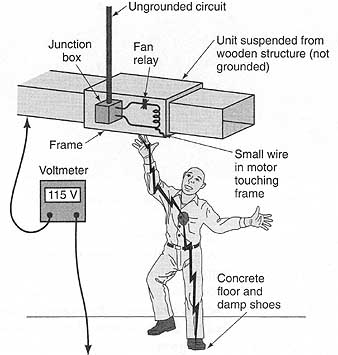
ill. 7 Technician receives electrical shock from grounded fan motor.
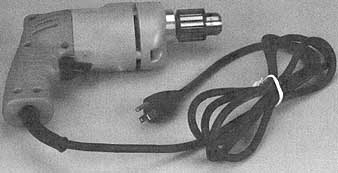
ill. 8 Electrical drill with three-prong grounded plug.
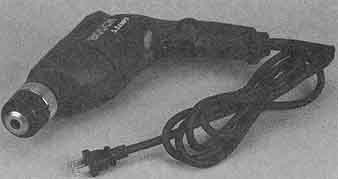
ill. 9 Double-insulated drill with two-prong plug
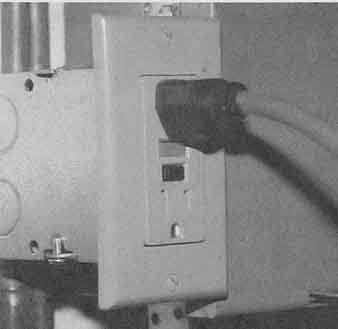
ill. 10 Ground fault circuit interrupter receptacle.
If an electrically powered tool requires a ground, it's equipped with a three-prong plug, as shown in ill 8. On this type of plug, the semicircular prong is the grounding section of the plug and should never be cut off or removed. The same goes for extension cords; the grounding prong should never be removed for convenience. It is important when using a power tool that requires a ground that the technician make certain that the receptacle is grounded. Electrical tools or cords with a ground prong that's altered should be taken out of service until replaced or repaired. A grounding adapter is a device that permits the connection of a three-prong plug to a two-prong receptacle. A grounding adapter shouldn't be used on a power tool with a three-prong plug unless there is a sure ground that the grounding wire can be attached to. The technician should use caution when using grounding adapters, because in many older structures grounding isn't pro vided at the receptacle box. Most late-model power tools are double insulated and don't require a ground. This type of tool will have a plug with only two prongs, as shown in ill 9.
A ground fault circuit interrupter (GFCI) is an electrical device that will open the circuit, preventing current flow to the receptacle when a small electrical leak to ground is detected. ill 10 shows a ground fault receptacle with an extension cord plugged into it. This type of receptacle is recommended for use with portable electric power tools. Ground fault circuit interrupters are also available in the form of circuit breakers, as shown in ill 1 Portable ground fault interrupters are available for use where permanent units are not available, such as on job sites. They are designed to help protect the operator from being shocked. Use ground fault circuit interrupters when required by the National Electrical Code®.
5 CIRCUIT PROTECTION
Electrical circuits in structures are designed to operate at or below a specific current (ampere) rating. Each electrical circuit should be protected, according to the NEC®. The wire or conductor of each circuit should be protected to prevent a higher current than it's designed to carry. The electrical components in the circuit are also a consideration when protection is a concern. The standard wire used for receptacles in most residences is #12 TW. The maximum current protection for this type of wire according to the NEC® is 20 amperes. However, if there is an electrical component in the circuit that requires protection at 10 amperes, the circuit protection should be at 10 amperes. If the current in the circuit becomes greater than the rating of the protective device, the device opens, disrupting the power source from the circuit.
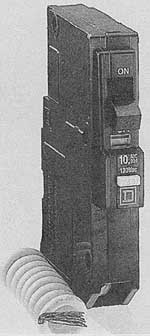
ill. 11 Ground fault circuit interrupter breaker
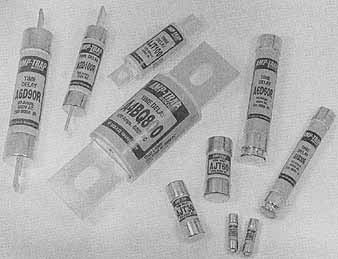
ill. 12 Fuses
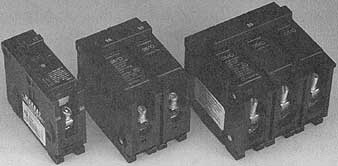
ill. 13 Circuit breakers
The most common methods of circuit protection in structures are fuses, as shown in ill 12, and circuit breakers, as shown in ill 13. These devices protect the circuit by interrupting the flow of electrical energy to the circuit if the current in the circuit exceeds the rating of the fuse or circuit breaker. There are many types of fuses available today with special designs for particular purposes, but the primary purpose of any fuse is protection. Fuses are made with a short strip of metal alloy called an element that has a low melting point, depending on the rating of the fuse. If a larger current flow passes through the fuse than is designed to pass through the element, the element will melt and open the circuit. Circuit breakers look a lot like ordinary light switches placed in an electrical panel. If the current in the circuit that a circuit breaker is protecting exceeds the breaker’s rating, then the switch of the circuit breaker will trip and interrupt the electrical energy going to the circuit. Fuses and circuit breakers should be sized for the particular application according to the National Electrical Code®. Technicians should never arbitrarily adjust the size of the fuse or circuit breaker without following the standards in the NEC® and local codes. Use only electrical conductors that are the proper size for the load of the circuit according to the NEC® to avoid overheating and possible fire.
6 CIRCUIT LOCKOUT PROCEDURES
Circuit lockout is a procedure that's used to interrupt the power supply to an electrical circuit or equipment. When a technician is performing work on a circuit where there is a possibility that someone might accidentally restore electrical power to that circuit, the technician should place a pad lock and /or a warning label on the valid switch or circuit breaker. When you are working in a residence, the chance of the homeowner closing switches that might affect your safety is remote but still possible, so use some type of warning tag or verbally inform the homeowner. When working in a structure where there are many people who could open and close switches, you should make absolutely certain that the electrical energy is disconnected from the circuit. Once the circuit's opened, mark the circuit so that others won't turn the circuit on while the repair is under way. In a commercial and industrial setting, this can be accomplished by using safety warning tags, padlocks, or locking devices made for that purpose. ill 14 shows a picture of a lockout tag-out kit used to safely disable an electrical device.
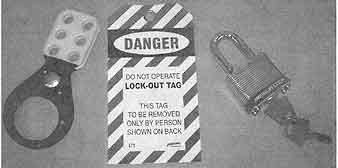
ill. 14 Lockout tag-out kit
7 ELECTRICAL SAFETY GUIDELINES
Follow the National Electrical Code® as a standard when making electrical connections and calculating wire sizes and circuit protection.
2. Make sure the electrical power supply is shut off at the distribution or entrance panel and locked out or marked in an approved manner.
3. Always make sure that the electrical power supply is off on the unit that's being serviced unless electrical energy is required for the ser vice procedure.
4. Always keep your body out of contact with damp or wet surfaces when working on live electrical circuits. If you must work in damp or wet areas, make certain that some method is used to isolate your body from these areas.
5. Be cautious when working around live electrical circuits. Don't allow yourself to become part of the electrical circuit.
6. Use only properly grounded power tools connected to properly grounded circuits.
7. Don't wear rings, watches, or other jewelry when working in close proximity to live electric circuits.
8. Wear shoes with an insulating sole and heel.
9. Don't use metal ladders when working near live electrical circuits.
10. Examine all extension cords and power tools for damage before using.
11. Replace or close all covers on receptacles that house electrical wiring and controls.
12. Make sure that the meter and the test leads being used are in good condition.
13. Discharge all capacitors with a 20,000-ohm, 4-watt resistor before touching the terminals.
14. When attempting to help someone who is being electrocuted, don't become part of the circuit. Always turn the electrical power off or use a nonconductive material to push the person away from the source.
15. Keep tools in good condition, and frequently check the insulated handles on tools that are used near electrical circuits.
SUMMARY
Electricity cannot be seen but it certainly can be felt. It only takes a small amount of electricity to cause injury or even death. It is imperative that heating and air-conditioning technicians respect and be cautious around electrical circuits. It only takes a slip or careless move to find oneself in danger of electrocution or injury. The technician must be careful and cautious around live electrical circuits.
It would be ideal if you never had to work in close proximity with live electrical circuits, but that isn't possible, especially when you are called on to troubleshoot heating and air-conditioning systems and equipment. You will be responsible for your own safety, and you should learn to respect and work carefully around live electrical circuits.
QUIZ
1. True or False: A heating and air-conditioning service technician can usually troubleshoot heating and air-conditioning systems without the voltage being supplied to the equipment.
2. What is a live electrical circuit?
3. Which of the following voltages will a refrigeration, heating, and air-conditioning technician come in contact with in the industry?
a. 24 volts
b. 120 volts
c. 240 volts
d. all of the above
4. Electrical shock occurs when a person ___.
a. touches an insulated wire
b. touches an electric motor
c. becomes part of an electric circuit
d. touches a conductor that has power applied to it, but is making contact with a ground
5. What are the important elements of electrical safety when working around live circuits?
6. Which of the following conditions is the most dangerous and likely to cause serious injury?
a. The technician touches a ground with his thumb and a live wire with his index finger.
b. The technician touches a live wire with his hand but is standing on an insulated platform.
c. The technician touches a live wire with his right hand and accidentally touches his right elbow on the metal part of the same unit.
d. The technician touches a live conductor with his right hand and touches a ground with his left hand.
7. Which of the following is the standard by which electrical installations are measured in the United States?
a. National Electrical Code
b. United Electrical Code
c. Basic Electrical Code
d. none of the above
8. True or False: A current flow of 0.1 ampere or less could be fatal.
9. What type of ladder should the technician use on the job?
a. aluminum
b. fiberglass
c. wood
d. both a and b
e. both b and c
10. What precautions should be taken when you see a coworker receiving an electrical shock?
11. True or False: It is recommended that at least one person on a truck know CPR.
12. True or False: The correct fuse size for an electrical circuit's one that's sized twice as large as needed for circuit protection.
13. What is the difference between a two-prong plug and a three-prong plug?
14. Which prong on a three-prong plug is the ground?
a. the left flat prong
b. the right flat prong
c. the center semicircular prong
d. none of the above
15. True or False: A grounding adapter does no good if it's not connected to an electrical ground.
16. An electrical device that will open an electrical circuit, preventing current flow to the circuit if a small leak to ground is detected, is called a ___
a. GFCI
b. common circuit breaker
c. fuse
d. receptacle
17. True or False: Receptacles used on the job site should be protected with a GFCI.
18. What precautions should you use when working in an area with a large number of people and you must disconnect the power from an appliance you are working on?
19. What is the difference between a fuse and a circuit breaker?
20. List at least five electrical safety rules that should be followed by refrigeration, heating, and air-conditioning technicians.